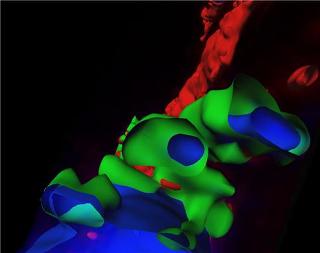Apr 10 2015
A team of scientists from the Institute for Biotechnology and Biomedicine at the UAB has produced an alternative to the use of viruses in gene therapy. The researchers synthesised nanoparticles which act as artificial viruses, capable of surrounding DNA fragments and releasing them as therapeutic agents, with no biological risk, into the interior of the cells.
 3D reconstruction of serial confocal sections showing protein (green)-DNA (blue) nanoparticles.
3D reconstruction of serial confocal sections showing protein (green)-DNA (blue) nanoparticles.
Researchers of the Nanobiology Unit from the Universitat Autònoma de Barcelona Institute of Biotechnology and Biomedicine, led by Antonio Villaverde, managed to create artificial viruses, protein complexes with the ability of self-assembling and forming nanoparticles which are capable of surrounding DNA fragments, penetrating the cells and reaching the nucleus in a very efficient manner, where they then release the therapeutic DNA fragments. The achievement represents an alternative with no biological risk to the use of viruses in gene therapy.
Gene therapy, which is the insertion of genes into the genome with therapeutic aims, needs elements which can transfer these genes to the nucleus of the cells. One of the possibilities when transferring these genes is the use of a virus, although this is not exempt of risks. That is why scientists strive to find an alternative. With this as their objective, emerging nanomedicines aim to imitate viral activities in the form of adjustable nanoparticles which can release nucleic acids and other drugs into the target cell.
Among the great diversity of materials tested by researchers, proteins are biocompatible, biodegradable and offer a large variety of functions which can be adjusted and used in genetic engineering. Nevertheless, it is very complicated to control the way in which protein blocks are organised, in order to form more complex structures which could be used to transport DNA in an efficient manner, as happens with viruses.
Professor Antonio Villaverde's group has discovered the combination necessary to make these proteins act as an artificial virus and self-assemble themselves to form regular protein nanoparticles capable of penetrating target cells and reaching the nucleus in a very efficient manner. In chemical terms, the key lies in a combination of cation-peptide and hexahistidine placed respectively at the amino and C-terminus ends of the modular proteins.
Researchers from the UAB have demonstrated that, when in the presence of DNA, these artificial viruses surround it and carry out structural readjustments so that the DNA is protected against external agents in a similar fashion to how natural viruses protect DNA inside a protein shell. Even the forms adopted by the resulting structures seem to imitate virus forms.
"It is important to highlight that this ability to self-assemble does not depend on the structural protein chosen and does not seem limited to one particular type of protein. This provides the opportunity to select proteins which could avoid any type of immune response after being administered, which is of great advantage in terms of therapeutic uses", Villaverde points out.
"These artificial viruses are promising alternatives to natural protein nanoparticles, including viruses, given that their limitations, such as a rigid architecture and a lack in biosecurity, can be less adequate when used in nanomedicine", states Esther Vázquez, co-author of the study and responsible for the Clinical Nanobiotechnology research line within the Nanobiotechnology Unit of the UAB Institute of Biotechnology and Biomedicine (IBB).
What occurs in chemotherapy as a cancer treatment can also be compared to the problems in gene therapy. Conventional treatments have an extremely high toxicity which limits their applicability. For this reason, UAB researchers, in collaboration with Professor Ramon Mangues from Sant Pau Hospital and Professor Ramon Eritja from CSIC, are now adapting these artificial viruses to be able to transport anti-cancer drugs directly to tumour cells. In this way, they will be capable of releasing large therapeutic doses in a very localised manner.